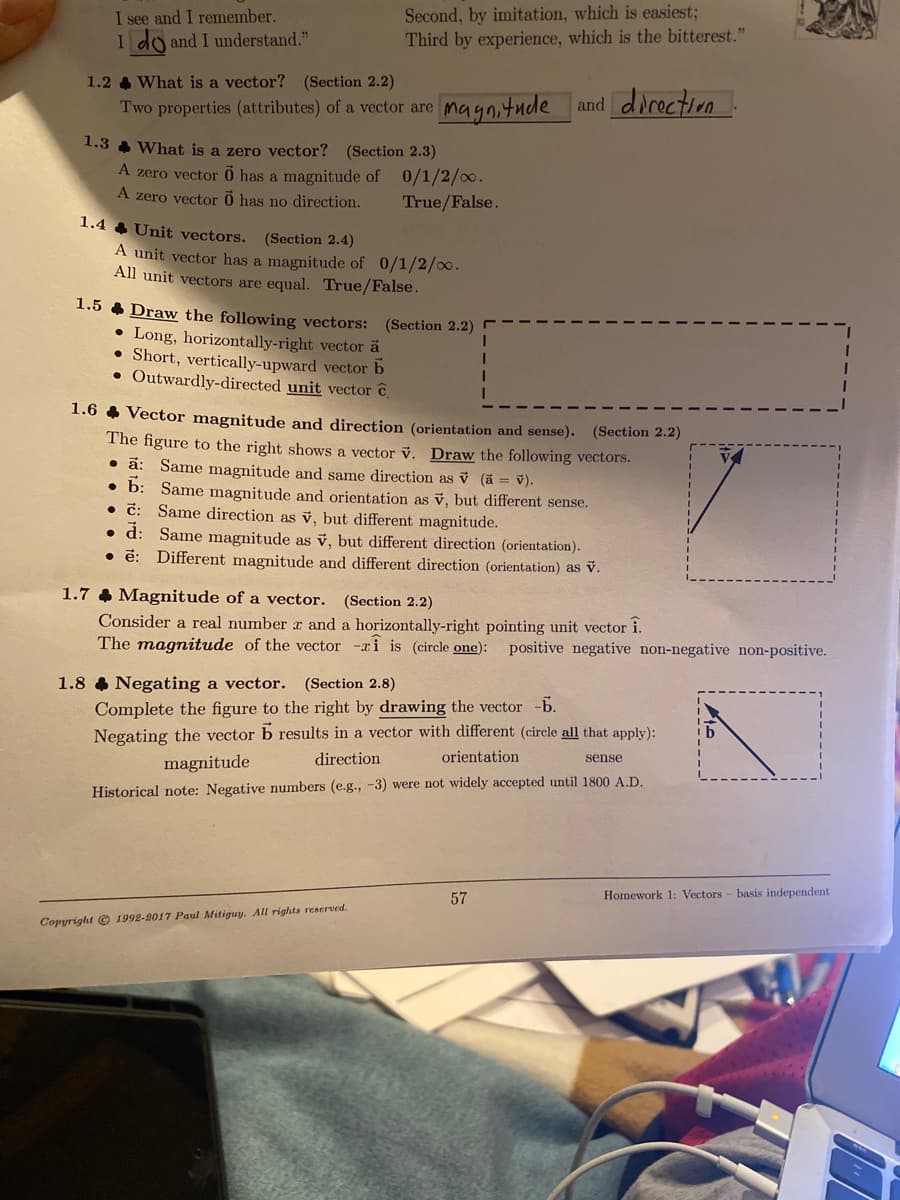tically-upward vector b • Outwardly-directed unit vector ĉ 1.6 4 Vector magnitude and direction (orientation and sense). (Section 2.2) The figure to the right shows a vector v. Draw the following vectors. • ä: Same magnitude and same direction as v (a • b: Same magnitude and orientation as v, but different sense. • č: Same direction as v, but different magnitude. • d: Same magnitude as ỷ, but different direction (orientation). • e: Different magnitude and different direction (orientation) as v. v). %3D 1.7 4 Magnitude of a vector. (Section 2.2) Consider a real number r and a horizontally-right pointing unit vector i. The magnitude of the vector -ri is (circle one): positive negative non-negative non-positive. .8 Negating a vector. (Section 2.8) Complete the figure to the right by drawing the vector -b. Negating the vector b results in a vector with different (circle all that apply):
tically-upward vector b • Outwardly-directed unit vector ĉ 1.6 4 Vector magnitude and direction (orientation and sense). (Section 2.2) The figure to the right shows a vector v. Draw the following vectors. • ä: Same magnitude and same direction as v (a • b: Same magnitude and orientation as v, but different sense. • č: Same direction as v, but different magnitude. • d: Same magnitude as ỷ, but different direction (orientation). • e: Different magnitude and different direction (orientation) as v. v). %3D 1.7 4 Magnitude of a vector. (Section 2.2) Consider a real number r and a horizontally-right pointing unit vector i. The magnitude of the vector -ri is (circle one): positive negative non-negative non-positive. .8 Negating a vector. (Section 2.8) Complete the figure to the right by drawing the vector -b. Negating the vector b results in a vector with different (circle all that apply):
College Physics
11th Edition
ISBN:9781305952300
Author:Raymond A. Serway, Chris Vuille
Publisher:Raymond A. Serway, Chris Vuille
Chapter3: Motion In Two Dimensions
Section: Chapter Questions
Problem 54AP: A landscape architect is planning an artificial waterfall in a city park. Water flowing at 0.750 m/s...
Related questions
Question
From 1.6 from a b c d and e draw the following vector

Transcribed Image Text:I see and I remember.
I do and I understand."
Second, by imitation, which is easiest3;
Third by experience, which is the bitterest."
1.2 & What is a vector? (Section 2.2)
Two properties (attributes) of a vector are
magnitude and direction
1.3 4 What is a zero vector? (Section 2.3)
A zero vector 0 has a magnitude of 0/1/2/.
A zero vector õ has no direction.
True/False.
1.4 4 Unit vectors. (Section 2.4)
A unit vector has a magnitude of 0/1/2/o.
All unit vectors are equal. True/False.
1.5 4 Draw the following vectors:
• Long, horizontally-right vector a
• Short, vertically-upward vector b
• Outwardly-directed unit vector C
(Section 2.2)
1.6 4 Vector magnitude and direction (orientation and sense). (Section 2.2)
The figure to the right shows a vector v. Draw the following vectors.
• ã: Same magnitude and same direction as v (a = v).
• b: Same magnitude and orientation as v, but different sense.
• č: Same direction as v, but different magnitude.
• d: Same magnitude as ỷ, but different direction (orientation).
• ē: Different magnitude and different direction (orientation) as v.
1.7 & Magnitude of a vector. (Section 2.2)
Consider a real number r and a horizontally-right pointing unit vector i.
The magnitude of the vector -ai is (circle one): positive negative non-negative non-positive.
1.8 & Negating a vector. (Section 2.8)
Complete the figure to the right by drawing the vector -b.
Negating the vector b results in a vector with different (circle all that apply):
direction
orientation
sense
magnitude
Historical note: Negative numbers (e.g., -3) were not widely accepted until 1800 A.D.
57
Homework 1: Vectors - basis independent
Copyright © 1992-9017 Paul Mitiguy. All rights reserved.
Expert Solution
This question has been solved!
Explore an expertly crafted, step-by-step solution for a thorough understanding of key concepts.
This is a popular solution!
Trending now
This is a popular solution!
Step by step
Solved in 3 steps with 3 images

Knowledge Booster
Learn more about
Need a deep-dive on the concept behind this application? Look no further. Learn more about this topic, physics and related others by exploring similar questions and additional content below.Recommended textbooks for you

College Physics
Physics
ISBN:
9781305952300
Author:
Raymond A. Serway, Chris Vuille
Publisher:
Cengage Learning

University Physics Volume 1
Physics
ISBN:
9781938168277
Author:
William Moebs, Samuel J. Ling, Jeff Sanny
Publisher:
OpenStax - Rice University

Principles of Physics: A Calculus-Based Text
Physics
ISBN:
9781133104261
Author:
Raymond A. Serway, John W. Jewett
Publisher:
Cengage Learning

College Physics
Physics
ISBN:
9781305952300
Author:
Raymond A. Serway, Chris Vuille
Publisher:
Cengage Learning

University Physics Volume 1
Physics
ISBN:
9781938168277
Author:
William Moebs, Samuel J. Ling, Jeff Sanny
Publisher:
OpenStax - Rice University

Principles of Physics: A Calculus-Based Text
Physics
ISBN:
9781133104261
Author:
Raymond A. Serway, John W. Jewett
Publisher:
Cengage Learning

Physics for Scientists and Engineers, Technology …
Physics
ISBN:
9781305116399
Author:
Raymond A. Serway, John W. Jewett
Publisher:
Cengage Learning